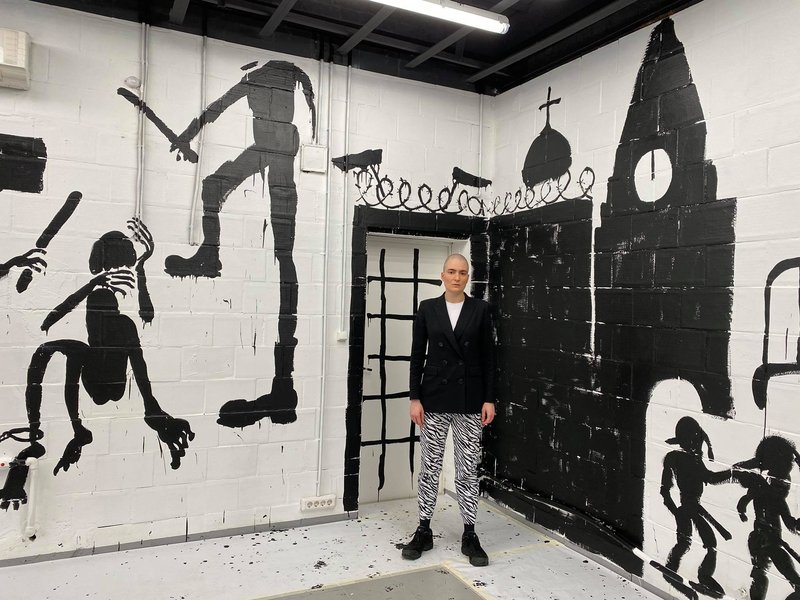Alice Yoffe's "Chance" project
Arthaus
Opening of the exhibition on December 8, 2022
Alice Yoffe's "Chance" project is the artist's first turn to abstraction in a long time (since 2015). It completes the period of developing a more direct use of social narratives. The absence of "depiction" of social relations on the surface of the canvas, however, does not mean that abstraction itself is "pure" art outside the context of its origin. Thus, Meyer Shapiro in his pivotal text "On the Nature of Abstract Art" proposed an acute social interpretation of abstraction. For him, the gestures and traces left by the author’s expressiveness condense into an allegory of the social structure of industrial capitalism. No matter how plotless, non-objective painting may be, this absence of a narrative brings attention to the meaning of the very use of artistic tools and methods. That is, in turning to abstraction, production relations reach their meaning in culture. With regard to Alice Yoffe's project, it is important that her work is done in an accessible application Procreate. The advertising slogans of this application read: "Take an art studio with you" and "sketch, draw, create". It is important for us how the modern market of consumer applications recreates the mythology proposed in the 19th century for a work of art. A sketch, a drawing, a creation (an artwork) is a pyramidal idea of bringing a certain creative idea out of oblivion. This advertisement reproduces almost verbatim the "classical" scheme of creating a work, making the "academic approach" accessible to the broadest digital masses. This idea of the creation continuity projects power hierarchies onto society itself. Rather than simply sustaining this myth, the "Chance" project builds resistance to its medium, which in this case is a mobile application and the order, the system of actions it imposes. Yoffe erases existing sketches with her finger on the tablet, emphasizes the "randomness of the finger", showing how chaotic the relationship between technology and the idea of pictorial skill can be. A researcher of Dickens's prose, Raymond Morris rightly wrote that Dickens's novels imply a new image of the city: "the city becomes the method of writing." Dickens shows that the system of a large industrial center seems to all its inhabitants a necessity and an imperious machine, whereas Dickens through writing shows the randomness of such a constellation. It is all woven of coincidences and extraordinary measures, which then become the conditions of life and the rules for generations to come. Subjecting the idea of the city to reverse-engineering, revealing the role of chance in its functioning, is an important moment for Dickens's modernism. In this project, Alice Yoffe talks about how transferring from the Procreate application to the canvas creates an architectural impression. Her project connects architecture to the randomness of fingers. The artist says that this project reinterprets or even parodies the suprematism of Malevich, for whom the elements really meant a view of the city and houses from the air. For the world of suprematism, the industrial city is the result of planning and a system. For Yoffe, the reference to suprematism reveals the "absurdity" of the first drawing, its connection to bodily movements. Thus, she criticizes the hierarchy from sketch to finished work, creating a parody of the modern city "creative" design. This city is not marked with a compass and ruler like Malevich, Rodchenko and Lissitzky - it is mediated by the demands of spontaneity and self-expression through applications. In this case, the very appeal to abstraction is not so much a reference to the conventions of painting as an analysis of the "creativity" conventions in digital applications.
Boris Klushnikov
 Alice Yoffe.
Born in 1987 in Tashkent. Lives and works in Moscow. In 2005–2007 she studied at the Free Workshops at the Moscow Museum of Modern Art. From 2007 to 2008 she studied at the Institute of Contemporary Art in Moscow.
In her works, Alisa Yoffe creates laconic black and white images with a wide brush. The artist often experiments with painting technology, combines different compositions to create paints. In her art she follows an expressive manner. The impulsive impulse is manifested not only in the artistic language that Alisa Yoffe uses, but also in the desire to go beyond the format. During work, images sometimes move from the canvas to the surrounding space - walls and ceiling. Alisa Yoffe often works on huge canvases and rolls of paper. Her exhibitions turn into total installations, where all the walls of the exhibition space are filled with expressive images. The author's style of the artist is grotesque characters depicted in the form of silhouettes on a white background. Smudges and splashes of black paint accentuate the atmospheric intensity of the presented plot: rock concerts, compositions on current social and political topics.
Alice Yoffe.
Born in 1987 in Tashkent. Lives and works in Moscow. In 2005–2007 she studied at the Free Workshops at the Moscow Museum of Modern Art. From 2007 to 2008 she studied at the Institute of Contemporary Art in Moscow.
In her works, Alisa Yoffe creates laconic black and white images with a wide brush. The artist often experiments with painting technology, combines different compositions to create paints. In her art she follows an expressive manner. The impulsive impulse is manifested not only in the artistic language that Alisa Yoffe uses, but also in the desire to go beyond the format. During work, images sometimes move from the canvas to the surrounding space - walls and ceiling. Alisa Yoffe often works on huge canvases and rolls of paper. Her exhibitions turn into total installations, where all the walls of the exhibition space are filled with expressive images. The author's style of the artist is grotesque characters depicted in the form of silhouettes on a white background. Smudges and splashes of black paint accentuate the atmospheric intensity of the presented plot: rock concerts, compositions on current social and political topics.
